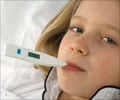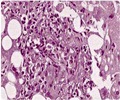Infants with a high fever may be at raised risk for infections such as meningitis and infections of the blood or urinary tract.

‘Parents of infants younger than eight weeks old should be encouraged to seek immediate care if their child develops a fever, a temperature more than 100.4 degrees Fahrenheit as they may be at raised risk for infections.’





"Young infants have underdeveloped immune systems and are susceptible to infection," Davis said. "Those with serious bacterial infections can experience a rapid decline in their condition if they are not diagnosed within an appropriate amount of time." According to Davis, the findings of the study, recently published in the Journal of Emergency Medicine, are an exception to the traditional teaching in medical education that the height of a fever doesn't necessarily correspond to the likelihood of infection. This exception to the rule only applies to infants younger than two months old.
"Parents bring children of all ages to the emergency room with high fevers because they are concerned, and it can be uncomfortable for the children," Davis said. "Fever height isn't as concerning in older children, because their bodies are more equipped to fight off serious bacterial infections."
In working with his colleague Erik Lehman, a statistician at the Milton S. Hershey Medical Center, Davis discovered that as the temperature rises in infants younger than 60 days old, their risk for serious bacterial infection increases.
For the study, Davis used data from the Pediatric Emergency Care Applied Research Network study on infants with fevers. He studied 4,821 eligible infants with a single, recorded fever who had at least one blood culture completed. The infants included had no record of prematurity, sepsis, or recent antibiotic use.
Advertisement
Duration and location were not associated with risk for infection, but there was a statistically significant relationship between the height of the fever and the risk of infection. According to Davis, serious bacterial infections occurred in 20.4 percent of infants with a fever, compared to 9.1 percent of infants with a lower temperature.
In future studies, Davis hopes to identify other factors that may put infants at increased risk for infections.
"The height of fever isn't enough to rule in or out a serious bacterial infection," Davis said. "It's one tool we may be able to use when identifying infants at high risk for infection."
Source-Eurekalert














